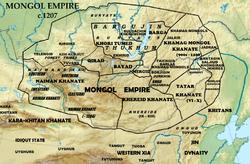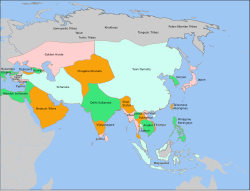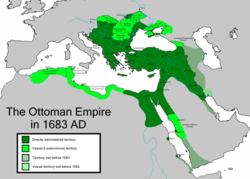World History empires name meanings study guide
Goal of this article is to help students identify context and historical recollection via definitions of historical names and terms
- along with memorizing names, places (map literacy) and dates
- historical knowledge and test-day recollection can be enhanced through etymology, or word origins of key historical places, empires or dynasties
Concepts & notes[edit | edit source]
Cultural Diffusion: are conquerors eventually conquered by the conquered?[edit | edit source]
- a common thread to studies of rise and fall of empires and dynasties is cultural diffusion
- cultural diffusion = the spreading and mixing of cultures, populations, technologies, disease, etc.
- we will see in this review over and over how many conquerors become more like the people and places they conquered than what / who they were at the start of the conquest
Standardization & unity[edit | edit source]
- empires rule and spread rule through the process of standardization
- while we think of standardization as making things the same, it can also mean treating disparate groups equally
- i.e., under legal or political standards of either tolerance or favor
- in such systems, different groups may be treated unequally, but in a standardized system, the law or governance treats them consistently, if not equally
- i.e., Islamic legal distinctions between Muslims and non-Muslims
- different taxes, military service, etc.
- i.e., Islamic legal distinctions between Muslims and non-Muslims
- typical methods of standardization and unity include
- writing / language
- laws
- taxation
- currency/ money
- road & canal building
- official religion and/or religious tolerance
China empires/ dynasties[edit | edit source]
| Name | Name definition | Dates | Region | Notes |
|---|---|---|---|---|
| Chinese dynasties follow four general categories of name origins: |
|
| ||
Yuan Dynasty[edit | edit source] |
|
1271–1368 |
| |
Ming Dynasty[edit | edit source] |
|
1368-1644 |
| |
Qing Dynasty[edit | edit source] |
|
1644–1911 | Manchuria, China |
|
Mongol empires[edit | edit source]
| Name | Name definition | Dates | Region | Notes | |
|---|---|---|---|---|---|
Mongol Empire[edit | edit source] |
|
1206–1368 | Eurasia |

 | none |
Yuan Dynasty[edit | edit source] |
see above under China dynasties for Yuan | 1271–1368 | |||
Golden Horde (Mongol)[edit | edit source] |
|
| |||
Chagatai Khanate[edit | edit source] |
|
1242-1347 /
1347-1487 |
| ||
Ilkhanate Khanate[edit | edit source] |
|
1256–1335 | Persia & northern Middle East/ Anatolia |

|
Europe monarchies/ empires[edit | edit source]
India empires[edit | edit source]
| Name | Name definition | Dates | Region | Notes |
|---|---|---|---|---|
| Timurid Empire |
|
1370–1507 | Persia (Iran), central Aisa, northern India |
|
| Mughal Empire |
|
1526–1857 |
Islamic Caliphates & empires[edit | edit source]
| Name | Name definition | Dates | Region | Notes |
|---|---|---|---|---|
Notes: on Islamic Caliphates and empires[edit | edit source] |
||||
|
 - Byzantine Empire controlled Asia Minor, Greece, Levant (eastern coast of Mediterranean) and North Africa - Sasanian Empire controlled Peria and Mesopotamia - Rashidun Caliphate controls Arabia and was highly expansionist  | |||
Rashidun Caliphate[edit | edit source] |
|
632–661 | Middle East, North Africa, southwestern Anatolia |
|
Umayyad Caliphate[edit | edit source] |
|
661–750 |
| |
Abbasid Caliphate[edit | edit source] |
|
750-1258 | Lower Middle East |
|
Mamluk Sultanate[edit | edit source] |
|
1250–1517 | Egypt, Levant |
|
Turks/ Seljuk Turks[edit | edit source] |
|
1037–1194 | Persia, Mesopotamia, Levant, Anatolia |
|
Ottoman Empire[edit | edit source] |
|
1517–1924 | Middle East, Anatolia, Southeastern Europe, Greece, North Africa |
 |
Safavid Empire[edit | edit source] |
|
1501-1736 | Persia, conquered Baghdad in 1508 (in modern day Iraq) |
|
Other dynasties, empires or concepts:
Gunpower empires[edit | edit source]

-->
